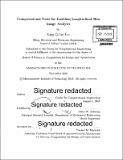| dc.contributor.advisor | Brian W. Anthony. | en_US |
| dc.contributor.author | Lee, Kang Qi Ian | en_US |
| dc.contributor.other | Massachusetts Institute of Technology. Computation for Design and Optimization Program. | en_US |
| dc.date.accessioned | 2017-02-22T19:01:39Z | |
| dc.date.available | 2017-02-22T19:01:39Z | |
| dc.date.copyright | 2016 | en_US |
| dc.date.issued | 2016 | en_US |
| dc.identifier.uri | http://hdl.handle.net/1721.1/107060 | |
| dc.description | Thesis: S.M., Massachusetts Institute of Technology, Computation for Design and Optimization Program, 2016. | en_US |
| dc.description | Cataloged from PDF version of thesis. | en_US |
| dc.description | Includes bibliographical references (pages 165-174). | en_US |
| dc.description.abstract | We present a set of computational tools that enable quantitative analysis of longitudinally acquired skin images: the assessment and characterization of the evolution of skin features over time. A framework for time-lapsed skin imaging is proposed. A nonrigid registration algorithm based on multiple plane detection for landmark identification accurately aligns pairs of longitudinal skin images. If dense and thick hairs are present, then nonrigid registration is used to reconstruct the skin texture of occluded regions by recording multiple images from the same area. Realistic reconstruction of occluded skin texture is aided by an automatic hair segmentation algorithm and guided painting method based on image blending. We demonstrate that constituent algorithms in this framework are accurate and robust in a multitude of scenarios. In addition, a methodology for rigorous longitudinal analysis of skin microrelief structure is introduced. Following rigid registration, a microrelief junction point matching algorithm based on point pattern matching is shown to accurately match two sets of junction points. Immediate applications for these computational tools are change detection for pigmented skin lesions and deformation field computation of the skin surface under stress using only visual features of the skin. Prospective applications include new insights in skin physiology and diseases from the capability to precisely track movements of the microrelief structure over time and localization of skin images on the body. | en_US |
| dc.description.statementofresponsibility | by Kang Qi Ian Lee. | en_US |
| dc.format.extent | 174 ages | en_US |
| dc.language.iso | eng | en_US |
| dc.publisher | Massachusetts Institute of Technology | en_US |
| dc.rights | MIT theses are protected by copyright. They may be viewed, downloaded, or printed from this source but further reproduction or distribution in any format is prohibited without written permission. | en_US |
| dc.rights.uri | http://dspace.mit.edu/handle/1721.1/7582 | en_US |
| dc.subject | Computation for Design and Optimization Program. | en_US |
| dc.title | Computational tools for enabling longitudinal skin image analysis | en_US |
| dc.type | Thesis | en_US |
| dc.description.degree | S.M. | en_US |
| dc.contributor.department | Massachusetts Institute of Technology. Computation for Design and Optimization Program | |
| dc.identifier.oclc | 971025685 | en_US |
